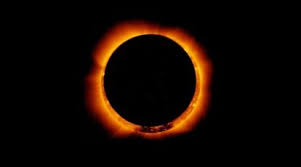Solar eclipse is such a unique astronomical phenomenon, which attracts astronomers as well as common people. In the year 2024, there is not one but two solar eclipses, the first of which has occurred on April 8 this year. This was a total solar eclipse. Although it was not seen in India, it was seen by many people through the internet and television. Now this has become a thing of the past and you should prepare for the second solar eclipse of the year, which is going to take place in October. This solar eclipse will be an annular eclipse, which is also called ‘Ring of Fire’. During this time the sun appears like a ring of fire. Why does a solar eclipse occur?
Our Earth revolves around the Sun while moving on its orbital path. At the same time, the Earth’s satellite, the Moon, also keeps rotating on its orbital path. During this journey, the Moon comes in a straight line between the Sun and the Earth, due to which the Sun is not visible and the sky appears dark. This astronomical phenomenon is known as solar eclipse. There are three types of solar eclipse – partial solar eclipse, annular solar eclipse and total solar eclipse. A partial solar eclipse occurs when the Moon’s shadow covers a small part of the Sun. During this time some part of the Sun is visible while the covered part appears black. An annular solar eclipse occurs when the Moon is in line with the Sun but due to its distance from the Earth, the Sun does not appear completely covered. During this time, a circular part is visible around the Sun which forms the shape of the Ring of Fire. During a total solar eclipse, the sun is not visible at all and a night-like scene is visible during the day. When is the second solar eclipse of the year?
According to the report of Space.com, the second solar eclipse of the year is going to occur on October 2. According to Indian time, this solar eclipse will start at 9:13 pm and will end at 3:17 am on October 3. In this way, this annular solar eclipse will last for 6 hours and 4 minutes. At its peak, the Moon will cover 93 percent of the Sun’s center.




